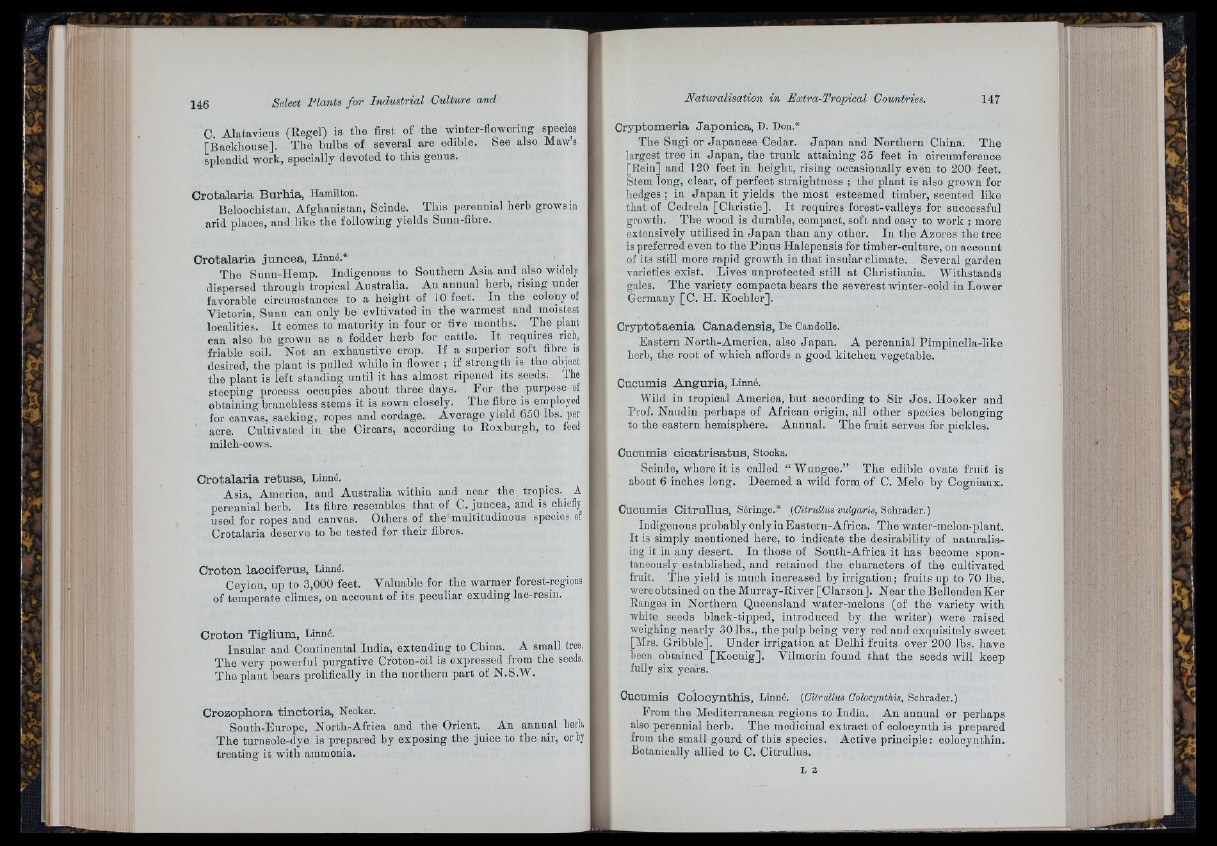
f i
tP. í ■
I
J-'
■Ì
146 Select Plants fo r Industrial Culture and
C. Alatavicus (Rege)) is the first of the winter-flowering species
[Backhouse]. The bulbs of several are edible. See also Maws
splendid work, specially devoted to this genus.
C ro ta la r ia B u rh ia , Hamilton.
Beloochistau, Afghanistan, Scinde. This perennial herb grows in
arid places, and like the following yields Sumi-libre.
C ro ta la r ia ju n c e a , Linné.*
The Suun-Hemp. Indigenous to Southern Asia and also widely
dispersed through tropical Australia. An annual herb, rising under
favorable circumstances to a height of iO feet. In the colony of
Victoria, Sunn can only be cvltivated in the warmest and moistest
localities. I t comes to maturity in four or five months. The plant
can also be grown as a fodder herb for cattle. I t requires rich,
friable soil. Not an exhaustive crop. If a superior soft fibre is
desired, the plant is pulled while in flower ; if strength is the ofriect
the plant is left standing until it has almost ripened its seeds. The
steeping process occupies about three days. For the purpose of
obtaining branchless stems it is sown closely. Tlie fibre is employed
for canvas, sacking, ropes and cordage. Average yield 650 lbs. per
acre. Cultivated in the Circars, according to Roxburgh, to feed
milch-cows.
C ro ta la r ia r e tu s a , Linné.
Asia, America, and Australia within and near the tropics. A
perennial herb. Its fibre resembles th a t of C. juncea, and is chiefly
used for ropes and canvas. Others of the mnltitudinous species of
Crotalaria deserve to be tested for their fibres.
C ro to n la c c ife ru s , Linné.
Ceyion, up to 3,000 feet. Valuable for the warmer forest-regions
of temperate climes, on account of its peculiar exuding lac-resin.
C ro to n T ig lium , Linné.
Insular and Continental India, extending to China. A small tree.
The very powerful purgative Croton-oil is expressed from the seeds.
The plant bears prolifically in the northern part of N.S.W.
C ro z o p h o ra tin c to r ia , Neoker.
South-Europe, North-Africa and the Orient. An annual herb,
The turiiBole-dye is prepared by exposing the juice to the air, or by
treating it with ammonia.
C ry p tom e ria J a p ó n ic a , D. Don.*
The Sugi or Japanese Cedar. Jap an and Northern China. The
largest tree in Japan, the trunk attaining 35 feet in circumference
[Rein] and 120 feet in lieight, rising oecasionally even to 200 feet.
Stem long, clear, of perfect straightness ; the plant is also grown for
hedges ; in Jap a n it yields the most esteemed timber, scented like
that of Cedrela [Christie]. I t requires forest-valleys for successful
growth. The wood is durable, compact, soft and easy to work ; more
extensively utilised in Jap an than any other. In the Azores the tree
is preferred even to the Finns Halepeusis for timber-culture, on account
of its still more rapid growth iu that insular climate. Several garden
varieties exist. Lives unprotected still at Christiania. Withstands
gales. The variety compacta bears the severest winter-cold in Lower
Germany [C. H. Koehler].
C ry p to ta e n ia C a n a d e n s is , De Candolle.
Eastern North-America, also Japan. A perennial Fimpinella-like
herb, the root of which affords a good kitchen vegetable.
Cucumis A n g u ria , Linné.
Wild in tropical America, but according to Sir Jos. Hooker and
Frof. Naudin perhaps of African origin, all other species belonging
to the eastern hemisphere. Annual. The fruit serves for pickles.
Cucumis o ic a tr is a tu s , Stocks.
Scinde, where it is called “ Wungee.” The edible ovate fruit is
about 6 inches long. Deemed a wild form of C. Melo by Cogniaux.
Cucumis C itru llu s , Séringe.* {Citrullws vulgaris, SahraAcr.)
Indigenous probably only in Eastern-Afrioa. The water-melon-plant.
It is simply mentioned here, to indicate the desirability of naturalising
it in any desert. In those of South-Africa it has become spontaneously
established, and retained the characters of the cultivated
fruit. The yield is much increased by irrigation ; fruits up to 70 lbs.
wereobtained on the Murray-River [ClarsonJ. Near the BellendenKer
Ranges in Northern Queensland water-melons (of the variety with
white seeds black-tipped, introduced by the writer) were raised
weighing nearly 30 lbs., the pulp being very red and exquisitely sweet
[Mrs. Gribble]. Under irrigation a t Delhi fruits over 200 lbs. have
been obtained [Koenig]. Vilmorin found that the seeds will keep
fully six years.
Cucumis C o io c y n th is , Linné. {Gitrnllus Golocynthis, Schrader.)
From the Mediterranean regions to India. An annual or perhaps
also perennial herb. The medicinal extract of colocynth is prepared
from the small gourd of this species. Active principle: oolooyuthin.
Botanically allied to C. Citrullus.
L 2